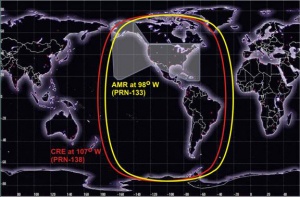If you wish to contribute or participate in the discussions about articles you are invited to contact the Editor
WAAS Space Segment
| WAAS | |
|---|---|
| Title | WAAS Space Segment |
| Author(s) | GMV. |
| Level | Basic |
| Year of Publication | 2011 |
The Wide Area Augmentation System (WAAS) is the United States Satellite Based Augmentation System. The programme, started in 1992, is being carried out by the Federal Aviation Agency (FAA)[1] and is specially developed for the civil aviation community.[2] The system, which was declared operational in late 2003,[3] currently supports thousands of aircraft instrument approaches in more than one thousand airports in USA and Canada.[4] WAAS service area includes CONUS, Alaska, Canada and Mexico.[5] The WAAS programme is continuously in evolution; two development phases have been already covered, a third is in progress, and there are plans to improve the capability of the system in parallel with the evolution of the SBAS standards towards a dual-frequency augmentation service.[6]
WAAS Space Segment
The WAAS Space Segment is composed by several geosynchronous communication satellites (GEO) in charge of broadcasting, over the WAAS service area, the WAAS augmentation message.
As of January 2011, the Space segment consists of two commercial satellites, Inmarsat-4 F3 and Telesat's Anik F1R, and also Intelsat's Galaxy 15, that has resumed service in March, 2011.[7]
The original two WAAS satellites, named Pacific Ocean Region (POR) and Atlantic Ocean Region-West (AOR-W), were leased space on Inmarsat III satellites. These satellites ceased WAAS transmissions on July 31, 2007. With the end of the Inmarsat lease approaching, two new satellites (Galaxy 15 and Anik F1R) were launched in late 2005. Galaxy 15 is a PanAmSat, and Anik F1R is a Telesat. As with the previous satellites, these are leased services under the FAA's Geostationary Satellite Communications Control Segment contract with Lockheed Martin for WAAS geostationary satellite leased services, who is contracted to provide up to three satellites through the year 2016. Since September 23, 2008, the ranging data that Galaxy 15 and Anik F1R transmit have been flagged as "Precision Approach". The Galaxy 15 satellite ceased responding to control commands between April 5, 2010, when solar activity damaged the spacecraft’s communication package, and December 23, 2010, when its battery drained and the Baseband Equipment command unit reset. During this time, the satellite drifted from its original location of 133 degrees west to 93 degrees west, but the WAAS signal continued to be broadcast until December 16, 2010. Intelsat has been able to return the satellite to its original location in March, 2011, back into operational mode, thereby restoring WAAS service to a large area in northwest Alaska.[7]
The list of GEO satellites used in WAAS are in the following table:
| Satellite Name & Details | NMEA / PRN | Location |
|---|---|---|
| Inmarsat 4F3 | NMEA #46 / PRN #133 | 98°W |
| Galaxy 15 | NMEA #48 / PRN #135 | 133°W |
| Anik F1R | NMEA #51 / PRN #138 | 107.3°W |
| Pacific Ocean Region (POR) Ceased WAAS transmissions |
NMEA #47 / PRN #134 | 178°E |
| Atlantic Ocean Region-West Ceased WAAS transmissions |
NMEA #35 / PRN #122 | 142°W |
Notes
References
- ^ Navigation Services - History - Satellite Navigation, FAA.
- ^ Navigation Services - Wide Area Augmentation System (WAAS), FAA.
- ^ Wide Area Differential GPS (WADGPS), Stanford University
- ^ GNSS - GPS/WAAS Approaches, Federal Aviation Agency (FAA).
- ^ WAAS Service Expanded into Canada and Mexico, September 28, 2007, Federal Aviation Agency (FAA).
- ^ SatNav News, Vol. 33, March 2008, Federal Aviation Agency (FAA).
- ^ a b FAA WAAS News

